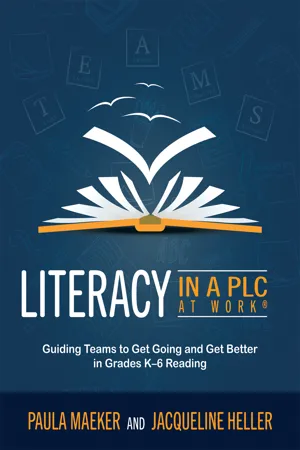
Literacy in a PLC at Work®
Guiding Teams to Get Going and Get Better in Grades K–6 Reading (Implement the PLC at Work® process to support student proficiency in literacy)
- 192 pages
- English
- ePUB (mobile friendly)
- Available on iOS & Android
Literacy in a PLC at Work®
Guiding Teams to Get Going and Get Better in Grades K–6 Reading (Implement the PLC at Work® process to support student proficiency in literacy)
About This Book
Explore how to provide equitable literacy instruction and assessment so every student masters essential standards. The authors help K–6 educators navigate reading and writing instruction through the lens of Professional Learning Communities at Work®. Learn strategies for utilizing data as collaborative teams to answer the four critical questions of learning, and access templates and protocols to improve literacy for all.
This book will help K–6 teachers and reading specialists:
- Analyze and improve their current literacy practices, curriculum, and instructional focus within the context of a PLC at Work
- Create or curate common formative team literacy assessments for learning targets
- Structure a supportive master schedule that allows for daily team collaboration and systemwide response
- Understand the components of a comprehensive literacy instructional block
- Create progress-monitoring tools and focused reading interventions and extensions
Contents:
Introduction
Chapter 1: Take Collective Responsibility and Work Interdependently
Chapter 2: Ensure a Guaranteed and Viable Curriculum
Chapter 3: Assess and Monitor Student Reading Growth With Ongoing Assessment
Chapter 4: Measure Evidence of Individual and Collective Teacher Practice Effectiveness
Chapter 5: Support Systematically With Targeted Acceleration, Interventions, and Extensions
Afterword: TEAMS Can Transform Literacy Outcomes for Students
Appendix A: TEAMS Process Protocols
Appendix B: TEAMS Templates
References and Resources
Index
Frequently asked questions
Information
Table of contents
- Cover Page
- Title Page
- Copyright
- Acknowledgments
- Table of Contents
- About the Authors
- Introduction
- Chapter 1: Teams Take Collective Responsibility and Work Interdependently
- Chapter 2: Ensure a Guaranteed and Viable Curriculum
- Chapter 3: Assess and Monitor Student Reading Achievement With Ongoing Assessment
- Chapter 4: Measure Effectiveness of Individual and Collective Teacher Practices
- Chapter 5: Support Systematically With Targeted Acceleration, Interventions, and Extensions
- Afterword
- Appendix A
- Appendix B
- References and Resources
- Index